Interwar Athens: A Journey Through Architectural Transformation
We join archaeologist and MONUMENTA coordinator...
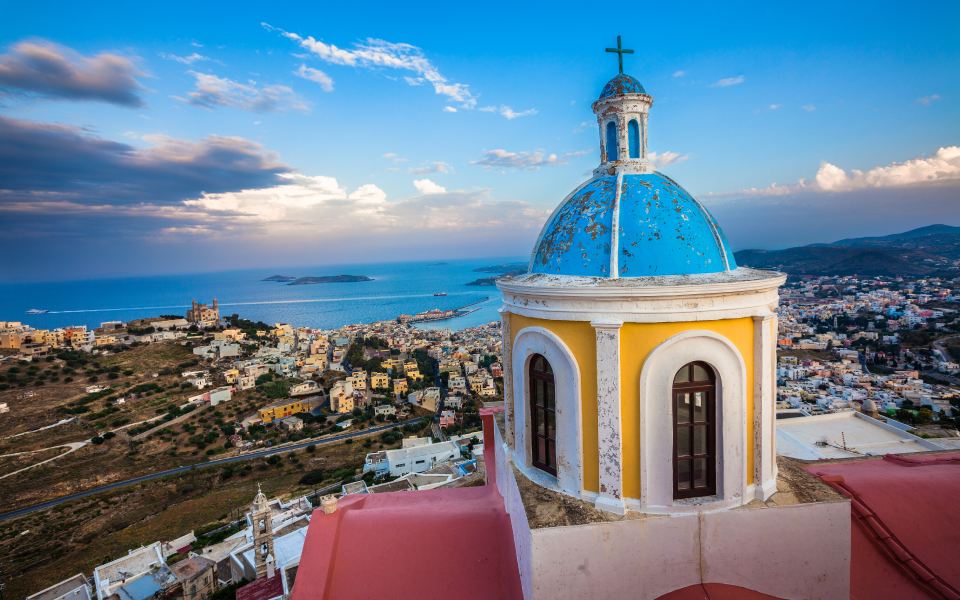
The Catholic church of San Tzortzis, Syros
© Shutterstock
The majority of foreign visitors to Greece are well aware that there’s a lot more to this sun-blessed country than its beaches, delicious food, beautiful scenery, and picturesque towns and villages. The world renowned Greek hospitality draws visitors in and invites them to explore the country’s rich culture, from hallowed antiquity to the present day, as well as the myriad local customs and traditions.
One aspect of Greek life that is striking for many is its religiosity, both on the individual level and the way it is publicly expressed in the various places of worship across the country. These places of worship, most notably Greek Orthodox churches, can easily catch a visitor’s attention – from the simple whitewashed chapels of the islands to historic churches and monasteries with monumental architecture and interiors of exquisite beauty.
There are numerous churches to visit in Greece, from the humble church of Kapnikarea in the midst of Athens’s busy shopping district, with its elegant Byzantine lines and beautiful decorations, to Aghios Andreas in Patras, the largest church in Greece. Here, we have compiled a list that contains a broad but representative expression of the places where Greeks go about their daily worship.
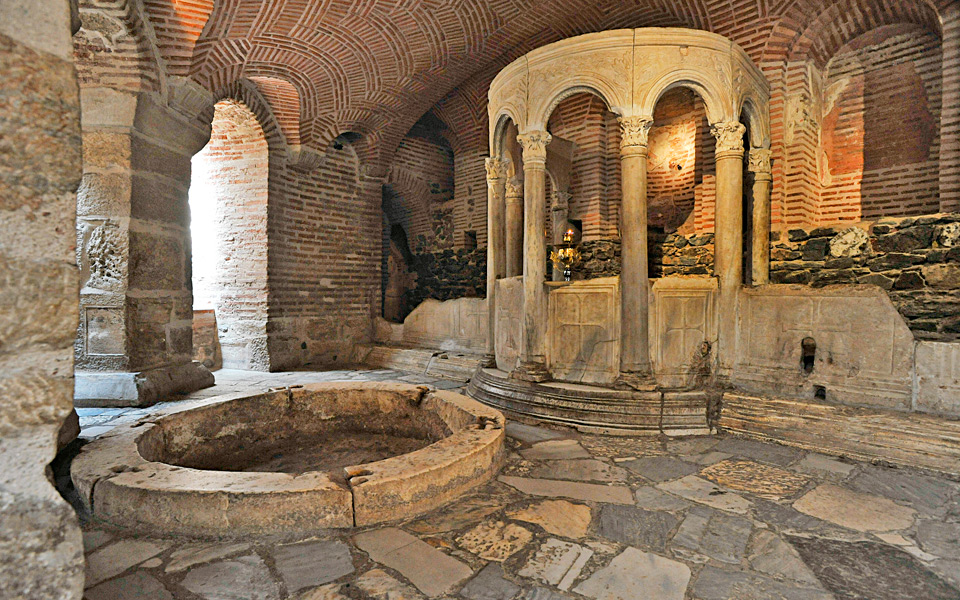
Crypt of Saint Demetrios, Thessaloniki
© Shutterstock
The destructive fire of August 1917 which destroyed a large section of the city of Thessaloniki deprived its residents and the wider Christian world of the exceptionally large and beautiful church of Saint Dimitrios.
The five-aisled basilica was built to honor the Roman general Dimitrios (or Demetrius), the son of a prominent family in the city, who was put to death around 306 AD during the persecutions of the Christians by the emperor Diocletian.
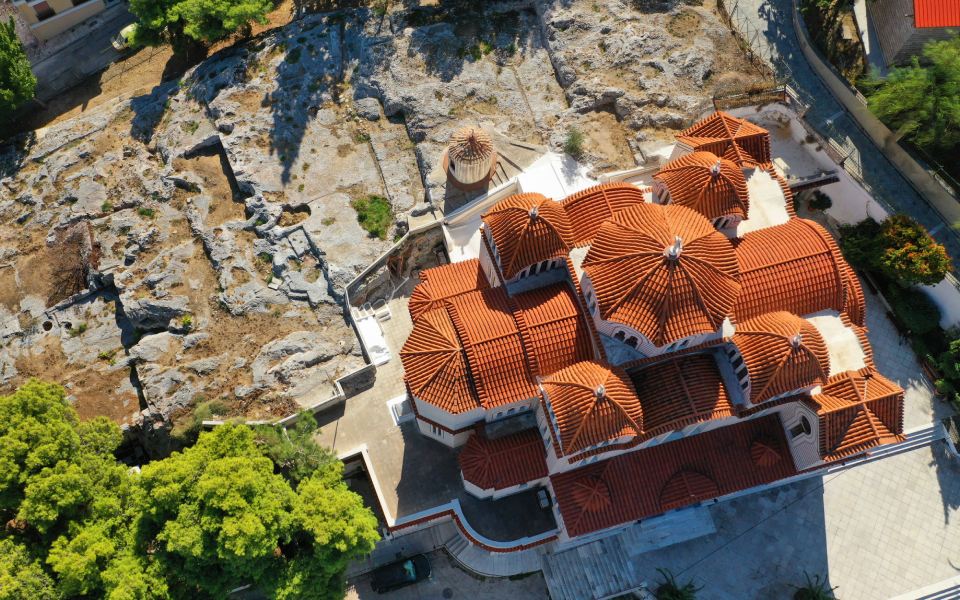
Saint Marina, Athens
© Shutterstock
The church of Saint Marina, situated in a prominent location on the Hill of the Nymphs in Thiseio, in Athens’s historic center, is not only beautiful inside and out, but conceals a “secret” which it shares with many churches. Although it was built relatively recently in 1927, restoration works in 1981-1986 revealed a much older church dating back to the 13th century with beautiful frescoes, which are now on display alongside the more recent images of the saints.
The church is a popular venue for weddings, while in the past pregnant women would slide down a rock in the church enclosure known as the “Kylistra” or “Tsouliastra,” and wish for an easy birth.
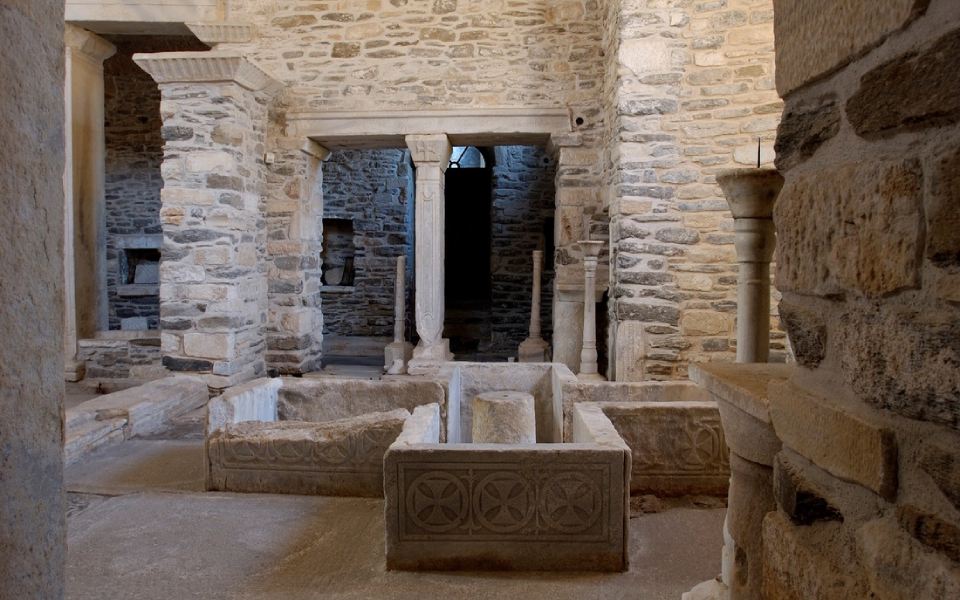
Panagia Ekatontapyliani, Paros
© ekatontapyliani.gr
Considered one of the largest Early Christian churches in Greece, Panagia Ekatontapyliani on the island of Paros celebrates the Dormition of the Virgin. According to tradition, it was built in the 4th century by St Constantine the Great following a dedication by his mother St Helen. In the 6th century the church was refurbished and a dome was added during the reign of the emperor Justinian, a little after the construction of Aghia Sophia in Constantinople.
The tradition linked to its name, which means “100 gates,” says that in addition to the 99 existing gates (meaning the number of apses in the church), a 100th will appear when the secret door in Aghia Sophia opens.
Ekatontapyliani is the site of one of Greece’s most important pilgrimages.
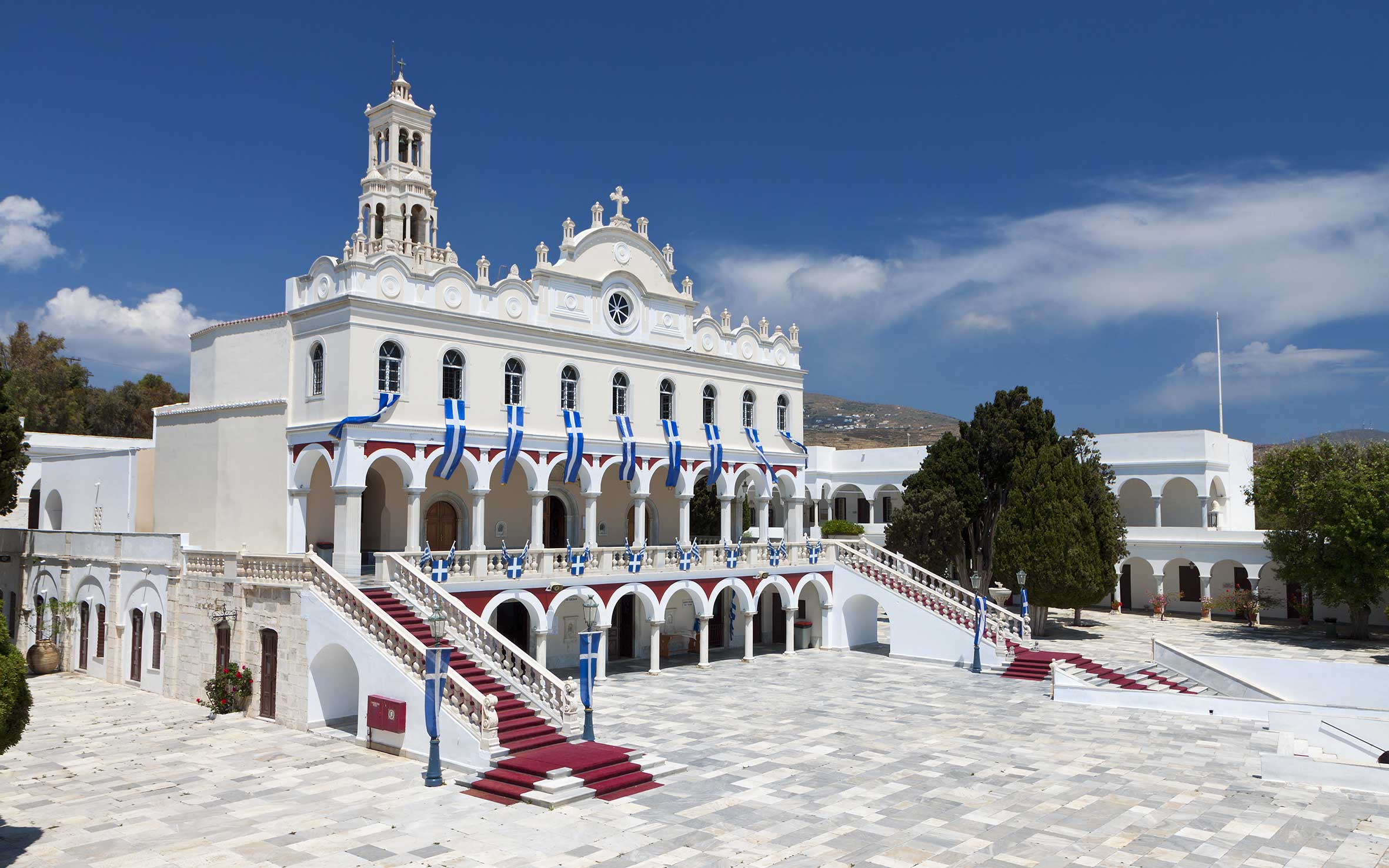
The Church of Panagia Evangelistria, Tinos
© Shutterstock
The Church of the Annunciation on Tinos is the biggest pilgrimage site for Greek Orthodox Christians. Although it is officially celebrated on the March 25, the pilgrimage and the celebrations peak on the festival of the Dormition on August 15, which is also a day of remembrance for the sinking of the battleship Elli, which preceded the start of the Greek-Italian war of 1940.
Construction of the imposing church started in 1823, shortly after the miraculous discovery of the icon of the Virgin following a vision seen by the nun Pelagia. It was the first church to be built in the midst of the Greek Revolution of 1821, but was not completed until 1880.
The church is renowned for the beauty of its frescoes and icons, as well as for the many artistic treasures found in the galleries of its foundation.
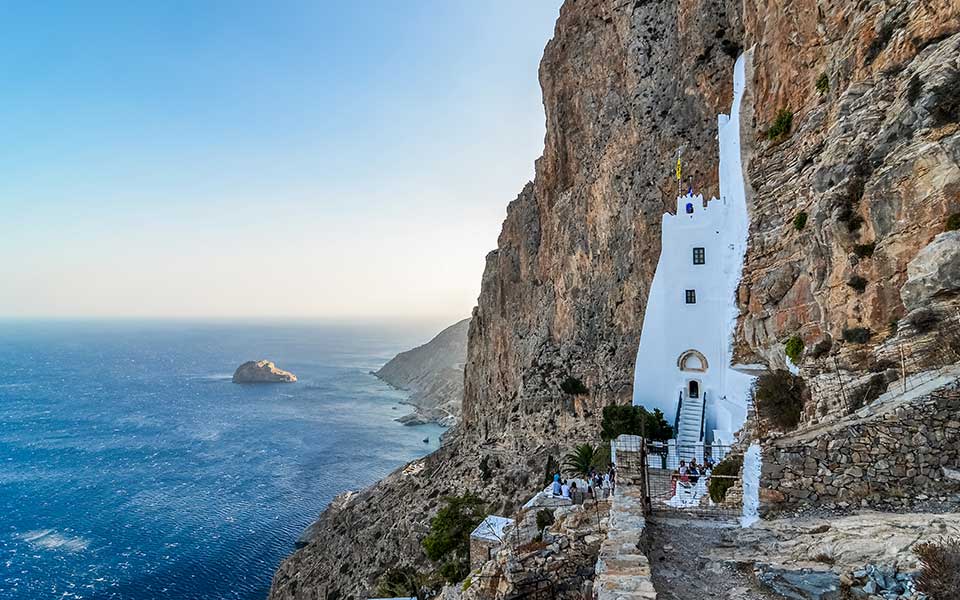
Panaghia Hozoviotissa, Amorgos
© Shutterstock
At 300 meters above sea level, built against a near-vertical rock face on the south coast of the island of Amorgos, sits the monastery of Panaghia Hozoviotissa, home to the icon of the Virgin bearing the same name. According to tradition, the icon arrived in a nearby bay in the 9th century during the Byzantine Iconomachy (“war on icons”). The monastery is said to have been founded shortly after the icon was found, and its name is a corruption of the Palestinian place name “Hazeva.”
All the buildings – the monks’ cells and dining hall, reception rooms and ceremonial rooms – are either carved out of the rock face or built against it.
The historic church, which celebrates its festival on November 20 and 21, is 40 meters long and painted according to the Byzantine tradition.

The Catholic church of San Tzortzis, Syros
© Shutterstock
Syros has dozens of churches, celebrating the peaceful coexistence of the faithful of the Cycladic islands’ two Christian Churches, Orthodox and Catholic. Two of these, the Orthodox church of the Resurrection and the Catholic church of San Tzortzis, are engaged in a friendly rivalry, occupying the tops of the two hills in the island’s capital Ermoupoli.
The first, which follows the Byzantine cruciform design with a dome, was designed in 1858, became functional in 1880 and officially inaugurated in 1907, is dedicated to the Resurrection of the Nation, and is decorated by beautiful 19th century icons. The second, which traces its beginnings in the 11th century, and has suffered many destructions and reconstructions, is a three-aisled basilica and is the boast of the Catholic congregation of Syros.
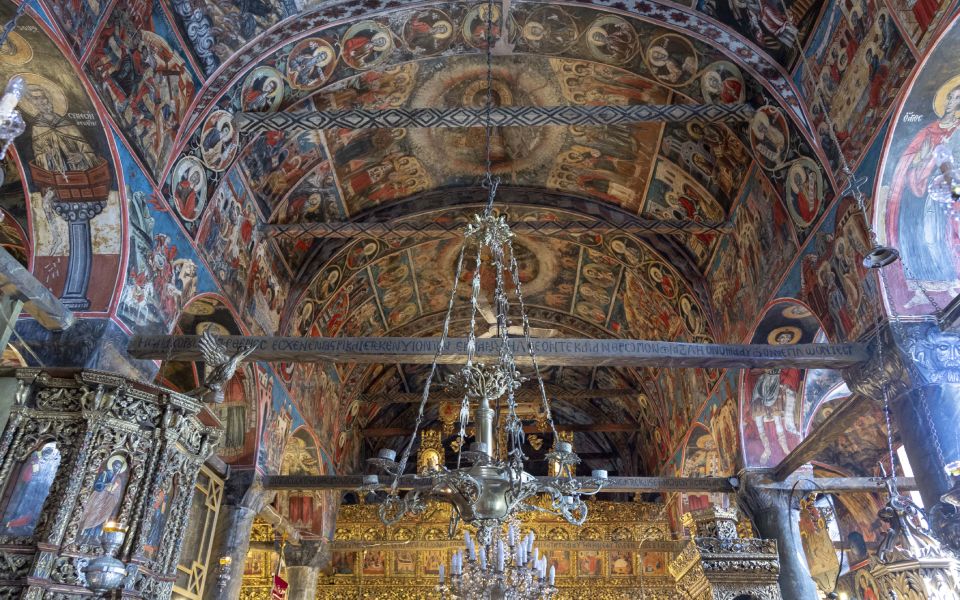
Church of the Taxiarchs, Milies, Pilio
© Perikles Merakos
Three things make Milies in Pilio special: the beautiful mountain scenery, “Moutzouris,” the steam train which transports you there, and the Church of the Taxiarchs. The outside of the latter is anything but conspicuous, purposely designed not to offend the Ottoman overlords during their 400-year occupation, but once inside, the visitor is greeted by an explosion of colorful frescoes, 12 domes perched atop a three-aisled basilica, and a hand-carved wooden altar.
The date of construction is not known, but the fact that it underwent a refurbishment in 1741 is commemorated by an inscription. It is a stunning example of traditional church architecture.
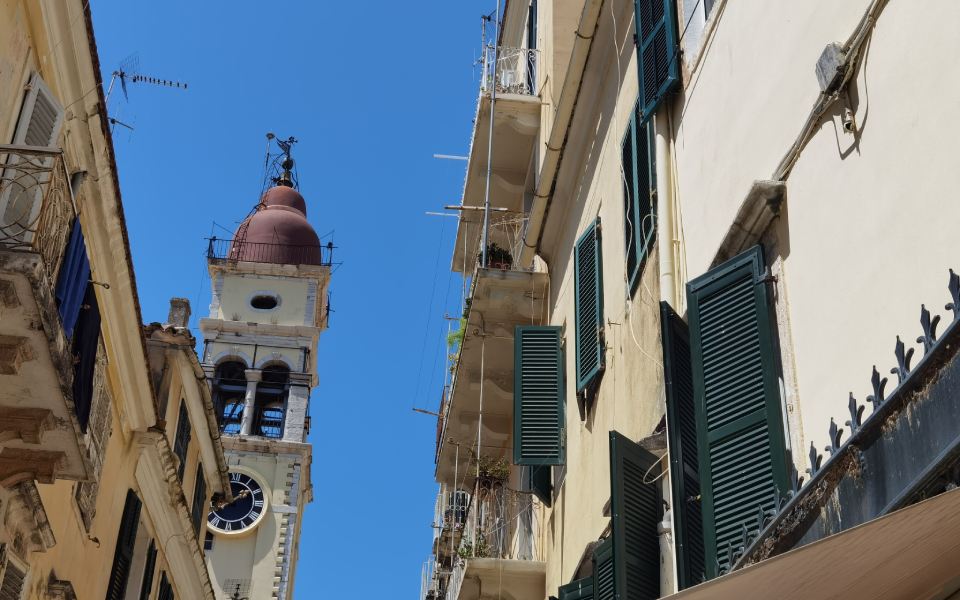
The church of St Spyridon, Corfu
© Shutterstock
In similar fashion to the Church of the Taxiarchs, the church of St Spyridon, patron saint of the island of Corfu, has a very simple exterior. On the interior, however, the beauty dazzles the visitor. Starting from the beautiful altar made of Parian marble, the eye is drawn to the beautiful “urania,” the church ceiling, which is divided into 17 painted sections with gold leaf frames, created by the local painter Panagiots Doxaras in 1727.
The most treasured possession of the church is the preserved remains of the saint, which is taken out on procession five times a year. The church was built between 1589 and 1594 by the family who had the remains in their possession, before surrendering them to the church authorities in early 1925.
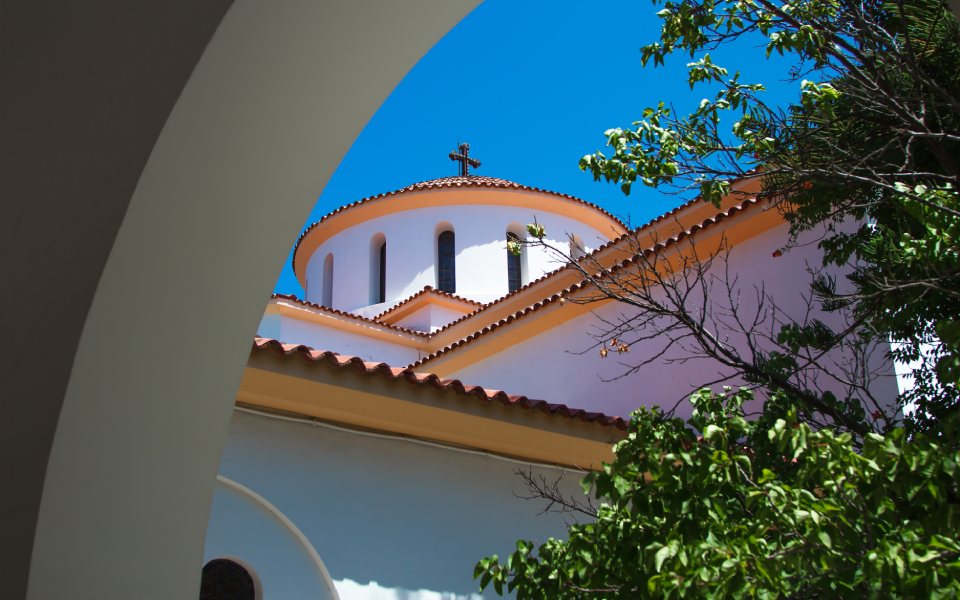
The church of the Catholic Virgin, Rhodes
© Shutterstock
On the island of Rhodes, near Filerimo and the ruins of ancient Ialysos, is the picturesque town of Kremasti, whose cathedral bears the name of the Catholic Virgin. It is built on the foundations of an ancient Byzantine church, which two surviving column capitals bear witness to, while an inscription above the narthex door tells us that it was refurbished in 1839.
The church is characterised by deeply traditional elements, while the icon of the Virgin – which is honored by Rhodians and large numbers of visitors – is said to “weep” on the eve of wars and other disasters.
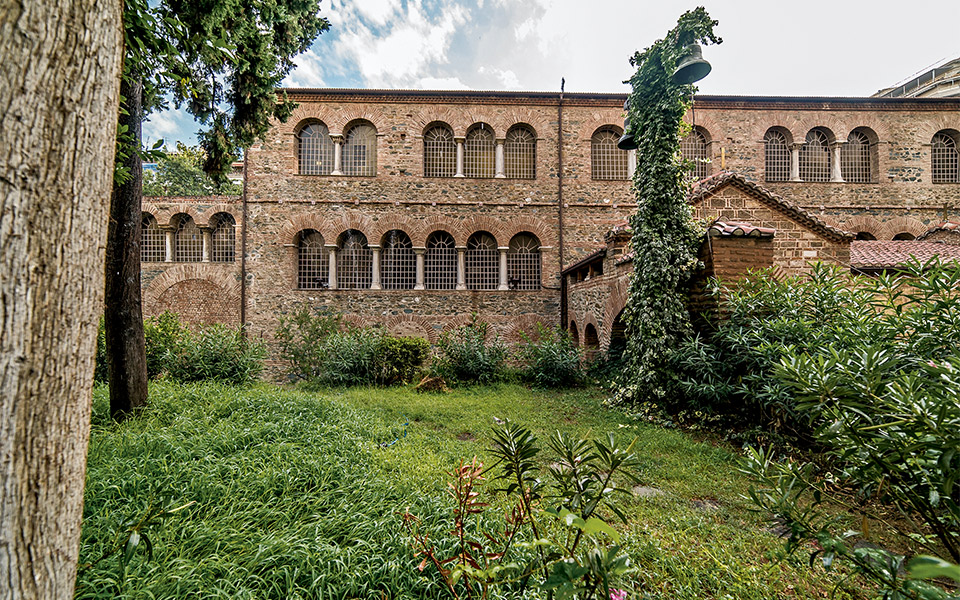
The Church of the Acheiropoietos, Thessaloniki
© Shutterstock
Churches of the Byzantine era are scattered across Greece, particularly in the north of the country – and visiting some of the surviving examples is a guaranteed way to experience Greek religious culture.
Many of the Byzantine churches not only display incomparable beauty and grace, but also offer rich artistic treasures in the form of frescoes, icons and interior architecture such as carved wood or marble icon stands. Examples include the the 12th-14th century churches of Kastoria, Mystras in Laconia, the churches of Saint Sophia, Acheiropietos, Saint Catherine and the Holy Apostles in Thessaloniki, Hosios Loukas in Viotia, and of course Mount Athos and Meteora.
We join archaeologist and MONUMENTA coordinator...
Vargiani on Mount Parnassos offers stunning...
While some historic buildings teeter on...
A brave history and uniquely beautiful...